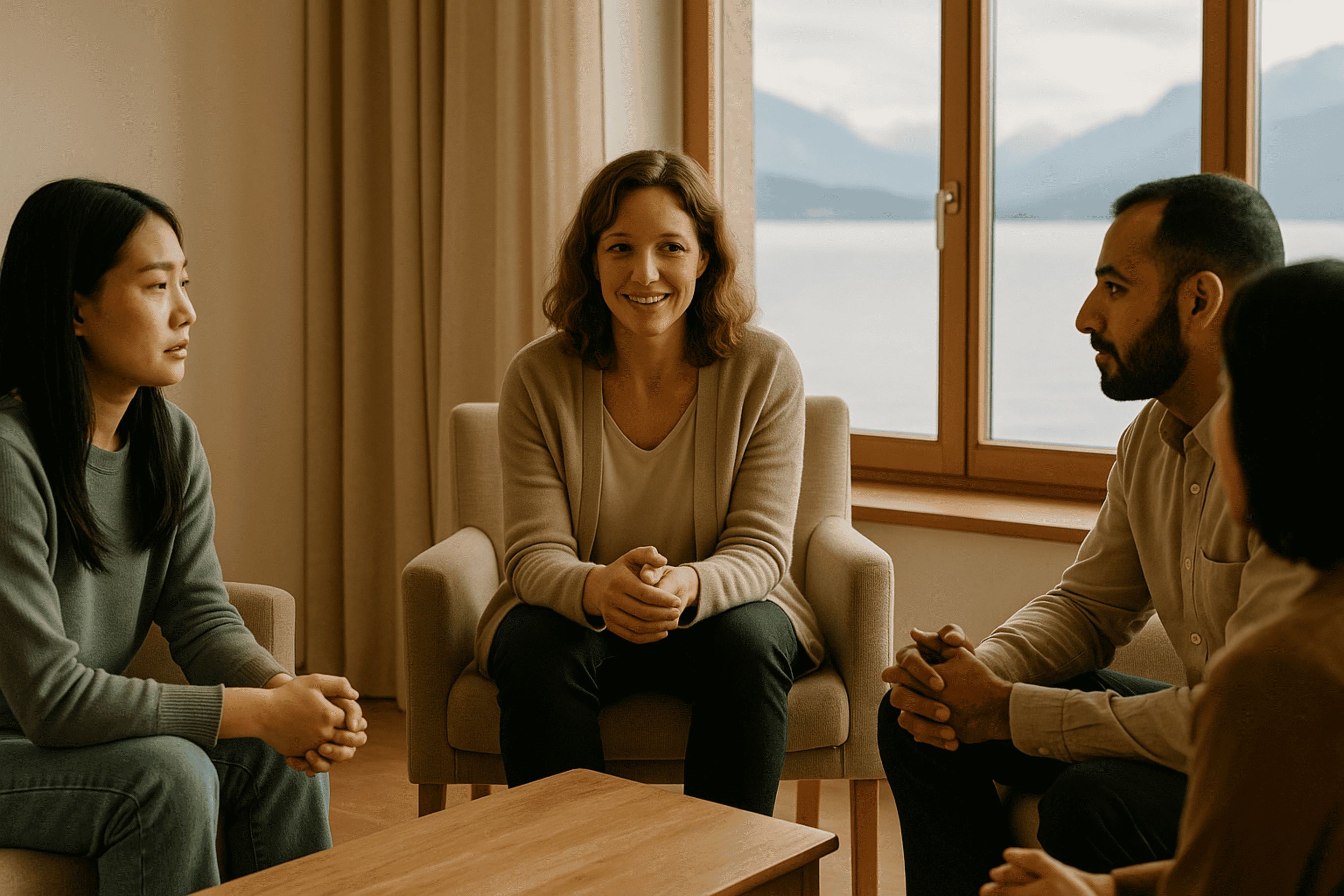Addiction affects people from every walk of life and every corner of the world. Yet the way people experience addiction and seek help is profoundly shaped by culture. In many cases, that cultural lens determines whether recovery even feels possible.
For international treatment centres like NEOVIVA, recognising cultural nuance isn’t just good practice, it’s essential. Western-based approaches, with their focus on openness, individual responsibility, and group sharing, don’t always translate in societies where family honour, privacy, or spiritual beliefs hold greater influence.
In many Eastern, Middle Eastern and collectivist cultures, emotional expression and self-disclosure can be seen as weakness or a threat to group harmony. Discussing personal struggles publicly, or even in private therapy, may feel inappropriate.
These dynamics shape whether someone admits they need help, how they respond to therapy, and how sustainable recovery is after treatment. When therapy overlooks those differences, clients can feel misunderstood, and the therapeutic process risks breaking down.
Culturally sensitive treatment has become a new frontier in addiction care, and at NEOVIVA, it guides how the team supports each client.
Meeting clients where they are
NEOVIVA’s clinical team consists of medical doctors, psychologists, psychotherapists, and counsellors from across Europe, Asia, and the Americas. For them, cultural sensitivity isn’t a buzzword; it’s the foundation of effective therapy.
“We have clients from cultures where sharing personal information is not necessarily a common practice or encouraged,” explains Dr. phil. Mayte Parada, NEOVIVA’s Clinical Lead. “We work with principles like those in Alcoholics Anonymous (AA) or Narcotics Anonymous (NA), where openness, honesty and sharing are central. But for some people, telling their family or community everything could actually do harm. So, we have to be realistic about what we can expect and how we support people from very different cultural backgrounds.”
Mayte recalls working with clients from Saudi Arabia and Qatar, where addiction is often treated with secrecy. “In these family systems, privacy is everything,” she says. “Telling them, ‘You can’t keep secrets, you have to tell everyone in the group everything,’ doesn’t help. It will most likely make things worse.”
“I can’t apply what I would to someone from here, to someone from a different cultural background or different country, and even different experiences can add to that. We still encourage group work; some have found it easier than others. It’s going home that is a different story.”
Instead, NEOVIVA’s therapists focus on what is possible within each client’s world. After the treatment programme, that might mean attending online support meetings rather than in-person groups. “We always ask, ‘What can they realistically do?'” explains Mayte. “We adapt to the framework that exists for them.”
Even with the best intentions, therapy can still collide with culture in unexpected ways.
When therapy and culture collide
Doctor-authority expectations versus collaborative therapy
Some clients, particularly those from hierarchical societies, come into treatment expecting the therapist to act like a doctor: to diagnose, to instruct, and to prescribe solutions. When faced with a more exploratory, client-led process, they can feel lost or frustrated.
Dr. phil. Mohammed Shafiullah, or Shafi as he is known to clients and colleagues, explains, “A common theme with clients from Middle Eastern or Asian cultures is that the concept of mental health is very blurred.”
“Therapists are like doctors, telling you what to do. In this culture, people go to the psychiatrist and get some tablets. But modern Western therapy doesn’t work like that. The key, he says, is to strike a balance. “You have to nudge clients gently towards opening up. Otherwise, they feel unsatisfied that they weren’t instructed on what to do.”
Gender and shame in family discussions
In other cases, deeply rooted gender norms can make specific topics, especially those involving family or marital conflict, too shameful to discuss openly. Shafi recalls a client who ended the therapeutic relationship when the conversation turned to problems at home.
“It was a taboo thing for him to admit to another man that there was a problem within his family,” he says. After some discussion, the client continued his therapy with Mayte. “For him to open up and speak about the problems with his wife became possible only because I’m not a man,” Mayte says.
Cultural respect versus clinical boundaries
On rare occasions, NEOVIVA has adapted policies to make treatment possible, for instance, allowing a spouse to stay on-site. In these cases, cultural or gender expectations made solo treatment unacceptable. “If we’d said no, they may never have received help,” says Mayte. “So, we set clear boundaries, and we made it work.”
NEOVIVA’s team focuses on repair, not avoidance. When cultural misunderstandings arise, they become part of the work and provide a chance to model open communication and rebuild trust. “We try to stay there and figure out what happened and whether there’s a way to repair it,” says Mayte. Sometimes, we can, and sometimes, we can’t. But the conversation itself is therapy.”
Cultural similarities and expectations
Cultural differences and apparent cultural similarities can both create challenges. When clients recognise a shared background or belief system, they may assume the therapist will think or behave in familiar ways. If that expectation isn’t met, it can lead to frustration, resistance, or a sense of betrayal.
Difference isn’t always visible. Sometimes it lies beneath the surface.
Culture isn’t just about where you are from
Shelley Heusser, one of NEOVIVA’s experienced psychotherapists, explains, “A patient from France can confront me with cultural differences just as much as someone from the Middle East. Cultural difference isn’t something exotic; it’s about how people are different from me in any way.”
Mayte agrees: “Even some families have their own culture, unspoken rules, hierarchies, or traditions. You have to work with those differences, too.”
Age and gender can also create cultural divides within therapy. “I’m currently working with someone who is 21 and recently worked with someone who was 65; their worldviews are completely different,” says Mayte. “The way they think about identity, relationships, and even addiction itself, is unalike.”
Shelley adds, “Gender itself is a cultural construct. Every time I’m in the room as a gay therapist, if I’m with a straight client or a woman, there’s a cultural difference at play. The work is to explore it.”
The therapist’s own culture
Therapists also bring their own cultural backgrounds, values, training, and personal histories into the room.
“We can’t pretend to be neutral,” says Shelley. “Our entire being, from where we grew up, our education, and our beliefs, influences how we work.”
For Shafi, acknowledging the differences from the outset helps to build trust. “I might look different to my client,” he says. “If we don’t address that, it can become an unspoken issue. The elephant in the room. So, I tell them where I am from and how I work. This transparency builds an alliance.”
Ironically, Shafi explains that it is sometimes hardest with people who do share his background. “They expect me to think and behave like them,” he says. “If I don’t, it can create tension. So, I have to be even clearer about what the therapy involves.”
Beyond the Western model
Most modern approaches, from cognitive behavioural therapy (CBT) to 12-step programmes, were developed in the West and carry an individualistic bias. For clients from collectivist cultures, that can feel alien.
“In the West, success or failure belongs to the individual,” explains Shafi. “In many Eastern cultures, it belongs to the family. There, if you get a PhD, you say, ‘My family will be proud. In the West, you say ‘I am proud of myself.’ That difference matters therapeutically.”
At NEOVIVA, some therapists use systemic and family-based approaches but adapt them carefully. “I was trained in systemic therapy, but the families I work with now are structured very differently,” says Mayte. “In Switzerland, you can invite the whole family to therapy. You can’t do that with a client from Saudi Arabia. The family is often huge, and some members, , may not be allowed to attend. So, I have to understand the system they live in and find the small areas where a change is possible.”
Culturally sensitive therapy doesn’t mean pairing clients and therapists by background. “You can’t say, ‘This gay client should see me’ or ‘That client from the East should see Shafi.’ If you do that, you risk losing something valuable. Sometimes the biggest healing happens across those divides,” explains Shelley.
Mayte agrees: “We’ve had women with trauma who have chosen to work with a male therapist, and it has been incredibly healing for that person. Therapy isn’t meant to keep people comfortable. You have to be uncomfortable to grow.”
Spirituality and belief
Belief systems also shape how people interpret addiction and recovery. “In some cultures, mental health and spirituality are intertwined,” says Shafi. “Someone might believe they’re suffering because they have sinned or are spiritually impure. So instead of seeing a therapist, they go to a spiritual leader for cleansing.”
He recalls helping one woman reframe her obsessive-compulsive disorder (OCD), which she saw as sinful. “I used her own faith to show her that what she was thinking and how she was behaving wasn’t a sin; that there was forgiveness in her scripture. It helped her to see that she wasn’t a bad person, but just someone struggling.”
Mayte takes a similar approach. “Even if I don’t share a client’s belief, I’m curious about it. I want to understand how it helps them, because it supports their healing, and we can integrate it into therapy.”
The cost of getting it wrong
When cultural humility is missing, the damage can be lasting. “Clients might terminate treatment and lose faith that anyone will ever understand them,” says Shelley. “That’s heartbreaking, but it’s often preventable.”
This sudden breakdown of the therapeutic relationship takes its toll on therapists, too. “When a client leaves abruptly, it is hard,” admits Shafi. “We are invested emotionally. So, we take it to supervision, to make sure we don’t carry that loss forward.”
Learning from each other
NEOVIVA’s multicultural team regularly debrief challenging cases together. “We come from different cultures, we speak different languages, we have different training backgrounds,” says Shafi. “That diversity is a hugely valuable tool. We debate, share, and find ways forward together.”
Mayte adds, “We all have different training and backgrounds. At NEOVIVA, it’s deliberate, so we’re not all doing the same thing. There are lots of opportunities to learn from someone else’s perspective. Clients need to see that they’re coming to a place where there isn’t just one way of thinking. Our diversity shows that healing doesn’t look the same for everyone, and that’s the point.”
A living practice of humility
For NEOVIVA, cultural sensitivity isn’t a box to tick; it’s an ongoing practice that asks as many questions as it answers.
“Every client confronts us with differences,” says Shelley. “If there are no ruptures or misunderstandings, something’s off. Rupture is part of therapy and part of learning who we are in relation to others.”
Mayte sums up the discussion with quiet pragmatism: “We can’t pretend to understand entire cultural systems, but we can find the small spaces where movement is possible. That’s where healing begins.”




0 Comments